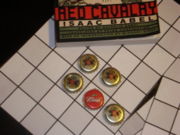Game of War: How to Play/Assembling the pieces
| Game of War: How to Play | |
|---|---|
| Training in how to play Guy Debord's Game of War: | What is the Game of War | Assembling the pieces | A guide to the rules | Strategy and Tactics | Playing the game |
The Board
Creating the Board
When Guy Debord devised the Game of War, he decided to restrict the board to a rectangle 25 squares wide and 20 deep. This can easily be recreated using the A4 sheet we are providing: Sheet for constructing Game of War Board
- Print 12 sheets out
- Attach sheets together putting 3 x 8 squares along the long edge, and 4 x 5 squares along the short edge (sheets can be attached using selotape or other suitable material
- Print 13th sheet out and cut 4 strips of three squares and 12 other individual squares
- Colour these as follows
- 4 strips of three: green = Mountains
- 2 individual squares light green: = Passes
- 2 individual squares red: = North Arsenals
- 2 individual squares yellow: = South Arsenals
- 6 individual squares black: = Forts
Guy Debord took the trouble to label the two long edges "N" and "S", referring to North and South, and place numbers along the top or North side, 1 to 25. The two sides were neither labelled "E" or "W", however he did place the letters A to T running down the left hand side. By this means he created a two-dimensional Cartesian coordinate system so that any individual square could be labelled by a unique reference consisting of a number for the horizontal axis and a letter for the vertical axis. (This is similar to algebraic chess notation). This is an optional refinement which can be omitted. However it is useful for recording movements in the game, and allows a simultaneous play variation of the game, whereby players can give written orders which are revealed simultaneously.
Debord also added the embellishment of a dashed line running across the board horizontally dividing the game into a Northern and Southern half. This is another innovation which can be regarded as optional.
Adding the Terrain
Guy Debord developed four types of terrain:
- Mountain: This is impassable to both pieces and to supportive fire
- Illustrated by bold lines at edge of mountain range with dotted shading
- Pass: This provides an extra defence bonus of 2, and cannot be charged by cavalry. This is located with two mountain squares adjacent to it on opposite faces
- Illustrated by bold lines at edge of pass with diagonal shading
- Arsenal: This provides a source for supply
- Illustrated by bold lines and three dotes in a diagonal line
- Fort: This provides an extra defence bonus of 4, and cannot be charged by cavalry
- Illustrated by bold lines and diagonal stub lines extending from corners into diagonally adjacent lines
Other terrain features have been developed by other players:
- River: This is impassable to pieces but does not block supportive fire
- Illustrated by bold lines along banks with horizontal shading lines
- Bridge: Like the pass, this provides an extra defence bonus of 2, and cannot be charged by cavalry, and can be recorded on the board in same way as a pass, except that it has two river squares adjacent to it on opposite faces.
- Illustrated by bold lines at edge of pass with diagonal shading
- Broken Ground: No charge through or into square. Cavalry must stop on entering square
- Illustrated by three wavy lines
Many players prefer to use different colours to illustrate their board. The sheets provided can simply be coloured in to indicate the terrain desired for game envisaged, or squares cut from coloured card can be used.
The Units

The military units can be created by using Marcel_Duchamp's technique of objet trouvé or readymades. You can find suitable household objects to utilise as pieces. As an example of this we have found bottle tops particularly aesthetically pleasing. These work well with boards constructed from the printouts we supply. These can sometimes be used without modification, with similar designs representing specific units of one side or another. Mounted unit can be indicated by having one bottle top resting on top of another. Or perhaps you can find bottle tops with a picture of a horse upon them. We use the Russian bottle tops with a 3 on them for artillery as they have a range of 3.
Guy Debord originally devised six types of unit:
| Name | Maximum Movement | Defence Combat Value | Attack Combat Value | Support Combat Range | Charge | Quantity in Original Game |
|---|---|---|---|---|---|---|
| Infantry | 1 square | 6 | 4 | 2 squares | No | 9 |
| Cavalry | 2 squares | 5 | 4 | 2 squares | Yes Attack strength 7 | 4 |
| Foot Artillery | 1 square | 8 | 5 | 3 squares | No | 1 |
| Horse Artillery | 2 squares | 8 | 5 | 3 squares | No | 1 |
| Foot Commander | 1 square | 1 | 0 | n/a | No | 1 |
| Mounted Commander | 2 squares | 1 | 0 | n/a | No | 1 |